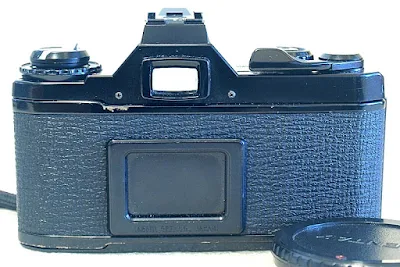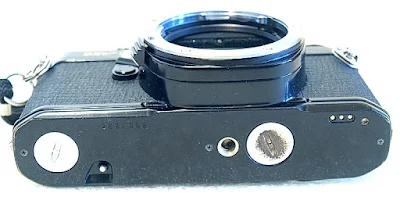The action was smooth with no noticeable body shake, a testament to a beautifully crafted SLR film camera that was made to last.
The Pentax MV1, an AE 35mm SLR film camera introduced in 1980, was an update to the Pentax MV launched a year earlier.
The camera utilizes a Seiko MFC vertical run metal focal-plane shutter, featuring a shutter speed range of 1 to 1/1000 second, synchronized at 1/100.
Over and abovue the previously released MV, advancements include a film winder attachment, a self-timer, an extended film ISO range from 32 to 1600, and a memo holder on the film back, which is exchangeable with the Dial Data ME data back.
For a slightly longer version of the camera's development, Pentax introduced the MX and ME in 1977. The ME was succeeded in 1979 by the more advanced ME Super and the simpler Pentax MV. The MV was, in turn, followed in 1980 by a less basic version, the Pentax MV1.
Introduction to the Pentax MV, Video 1 of 2
Pentax built the MV for one year -- 1979 -- before replacing it with the MV-1. The MV represented Pentax's 35mm SLR with the fewest features and least user control. Designed specifically for people who wanted an SLR supported by good lenses but who would use it mostly for point-and-shoot photography, the MV supports only limited functionality.
Compact and easy to handle, the MV1 deploys a center-weighted TTL (through-the-lens) open aperture metering system activated by a slight pressure on the release button. The lightweight body, which is also available in chrome, weighs in at 425 grams without batteries and needs a pair of alkaline button cells (LR44) to operate.
Being an aperture priority autoexposure model, the Pentax MV1 does not have a shutter speed selection option. Lenses for the MV1 are interchangeable with the SMC Pentax-M series introduced with the M series cameras and other K-mount series lenses.
Basic Camera Features
For a vintage 35mm SLR film camera that is hardly featured by reviews or reviewers on the Net, the MV1 is a bit of a marvel, really. A smooth operator, the camera came with a solid body build, and as I mentioned earlier, a mirror flap system that is very well-damped to eliminate mechanical body shake.
Similar in form to most other SLR cameras of that era, the design of the front plane of the camera is a straightforward, simple affair occupied only by the lens mount housing with the lens release button on the left of the mount, and the self-timer mechanism up close to the shutter release assembly, which is on the top plane.
On the top plane, from left to right, is the film rewind crank integrated with the film back pull-up latch lock and film ASA selection dial. A hot shoe is on the apex of the pentaprism housing, the shutter release and shutter mode dial cluster to its right, and towards the right shoulder of the top plate, the film forward lever crank, and a frame counter window.
The film back is plain, with a film memo tab located centrally, and on the back of the top plane, under the pentaprism hump, the viewfinder window.
Located on the bottom plate are a capped film sprocket coupler, film rewind release button, tripod socket, battery chamber, and winder contacts.
The film box is a quick-load system, which requires you to slit in the film tab end between any of the white pins of the take-up spool, aligning the film to the sprocket holes before closing the back the nominal two-blank shots to bring the film to Frame 1.
Viewfinder Readout
The viewfinder of the MV1 is an aluminum-coated pentaprism finder, displaying 92% of the image field, with a centrally located split/image microprism focusing screen. A third-height vertical bar with three LED glowlight displays is located on the left of the screen.
The displays are Green (the middle potion) for adequate hand-held shooting with automatic speed selection from 1/30 to 1/1000 second, Red (at the top of the bar) for overexposure, and Yellow (at the lower end of the bar) for the slower speeds for which the camera is recommended to be placed on a tripod or to be used with a flash unit.
Unlike other cameras with LED indicators, the LED display on the MV1 is more of a damped glow rather than a bright LED light spot.
Shutter speed selection, aside from 1/100, and Bulb, which is neither shown nor selectable on the MV1.
Self-Timer
The self-timer on the MV1 is a self-activated system. This is done by first turning the self-timer lever anti-clockwise to the estimated delay duration (from 4 to 10 seconds) position, and activating it by a slight push of the lever itself.
Aperture Priority Shooting
Aperture priority shooting is normally a two-handed operation, with the right hand holding the camera and the index finger on the shutter release button, half-pressed to activate the metering system. The left hand is the cradle support for the camera's body, with the thumb and index finger used for both focusing and adjusting the lens aperture opening.
Use the focus ring on the front of the lens to get the image frame or image subject aligned with the split/image microprism finder. With your right index finger half-pressed on the shutter release button, move your left-hand fingers slightly backward to adjust the aperture ring till the LED bar glows. Press the shutter release fully, and the image you captured will be in focus with the right exposure.
Battery
The MV1 requires a pair of LR44 or SR44 button cells to operate the metering system and shutter speed control. When the battery is depleted, the camera will default to a shutter speed of 1/100 second.
Camera Body Weight
The Pentax MV1 camera's body weighs 425 grams without batteries.
Early Images
The camera/lens combo was light and versatile enough for me to enjoy the first roll of shots, taken with an SMC Pentax-M 40mm F2.8 lens attached, on a short walk around a familiar tourist spot in the city.
The film advance was smooth, the metering was right on most of the time, and with the 40mm lens attached, I could not ask for more.
Incidentally, while there is still a discussion on what is a good lens for street photography, many will opt for the wide-angle 28mm or 35mm primes as a better selection.
I beg to differ. For me, the perfect in-between within the range from 35mm to 50mm is the one that you use for the city's streets, a 40mm prime, and, in this case, the SMC Pentax-M 40mm F2.8.
Well, if you are into or just about to get into film photography, and if you are a bit apprehensive about upfront costs, do not worry, 35mm SLR film camera kits are easy to get and are really affordable; they will not cost you an arm or a leg.
For a highly recommended make and model, the Pentax MV1, with a legendary SMC Pentax-M lens attached, is as good a start as any.






























No comments:
Post a Comment